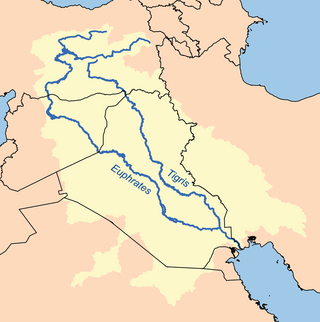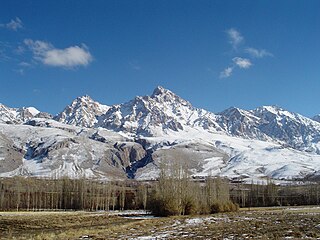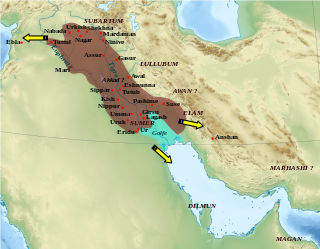Related Research Articles

A constellation is an area on the celestial sphere in which a group of visible stars forms a perceived pattern or outline, typically representing an animal, mythological subject, or inanimate object.

The Euphrates is the longest and one of the most historically important rivers of Western Asia. Together with the Tigris, it is one of the two defining rivers of Mesopotamia. Originating in Turkey, the Euphrates flows through Syria and Iraq to join the Tigris in the Shatt al-Arab in Iraq, which empties into the Persian Gulf.

The geography of Iraq is diverse and falls into five main regions: the desert, Upper Mesopotamia, the northern highlands of Iraq, Lower Mesopotamia, and the alluvial plain extending from around Tikrit to the Persian Gulf.

The Tigris is the eastern of the two great rivers that define Mesopotamia, the other being the Euphrates. The river flows south from the mountains of the Taurus in Turkey, then through the Syrian and Arabian Deserts, emptying into the Persian Gulf.
Opis was an ancient Near East city near the Tigris, not far from modern Baghdad. The equivalence of Opis and Upi are now usually assumed but not yet proven. Early on it was thought that the ideogram for Upi might refer to Kesh or Akshak. Its location is not yet known with certainty though Tall al-Mujailāt has been proposed. That site has also been suggested as the location of the ancient city of Akshak.

The Tigris–Euphrates river system is a large river system in Western Asia that discharges into the Persian Gulf. Its principal rivers are the Tigris and Euphrates, along with smaller tributaries.

Petrus Plancius was a Dutch-Flemish astronomer, cartographer and clergyman. He was born as Pieter Platevoet in Dranouter, now in Heuvelland, West Flanders. He studied theology in Germany and England. At the age of 24 he became a minister in the Dutch Reformed Church.

The Taurus Mountains are a mountain complex in southern Turkey, separating the Mediterranean coastal region from the central Anatolian Plateau. The system extends along a curve from Lake Eğirdir in the west to the upper reaches of the Euphrates and Tigris rivers in the east. It is a part of the Alpide belt in Eurasia.

The Caspian tiger was a Panthera tigris tigris population native to eastern Turkey, northern Iran, Mesopotamia, the Caucasus around the Caspian Sea, Central Asia to northern Afghanistan and the Xinjiang region in western China. Until the Middle Ages, it was also present in southern Russia. It inhabited sparse forests and riverine corridors in this region until the 1970s. This population was regarded as a distinct subspecies and assessed as extinct in 2003.

Quadrans Muralis was a constellation created by the French astronomer Jérôme Lalande in 1795. It depicted a wall-mounted quadrant with which he and his nephew Michel Lefrançois de Lalande had charted the celestial sphere, and was named Le Mural in the French atlas. It was between the constellations of Boötes and Draco, near the tail of Ursa Major, containing stars between β Bootis (Nekkar) and η Ursae Majoris (Alkaid).

Taurus Poniatovii was a constellation created by the former rector of Vilnius University, Marcin Odlanicki Poczobutt, in 1777 to honor Stanislaus Poniatowski, King of Poland and Grand Duke of Lithuania. It consisted of stars that are today considered part of Ophiuchus and Aquila. It is no longer in use. It was wedged in between Ophiuchus, Aquila and Serpens Cauda. A depiction of the constellation can be found on the wall of the Vilnius University Astronomical Observatory.
Jordanus was a constellation introduced in 1612 on a globe by Petrus Plancius and first shown in print by Jakob Bartsch in his book Usus Astronomicus Planisphaerii Stellati (1624).
Seleucia was an ancient city near the Euphrates river and across the Tigris from the better-known Seleucia on the Tigris, in Sittacene, Mesopotamia. The editors of the Barrington Atlas of the Greek and Roman World place the city at Sliq Kharawta in central Iraq.
Al-Qurnah is a town in southern Iraq about 74 km northwest of Basra, that lies within the conglomeration of Nahairat. Qurna is located at the confluence point of the Tigris and Euphrates rivers to form the Shatt al-Arab waterway. Local folklore holds Qurnah to have been the original site of biblical paradise, the Garden of Eden, and location of the Tree of Knowledge.
The Tigris is the eastern member of the two great rivers that define Mesopotamia.
The New River is a river of South America located in the southeastern region of Guyana. It forms the Western border of the Tigri Area or New River Triangle, a disputed territory that is claimed by both Guyana and Suriname. In 1965, to bolster this territorial claim, the Surinamese government issued a decree to begin referring to the river as the Upper Corantyne River in Suriname.

Akkad was the capital of the Akkadian Empire, which was the dominant political force in Mesopotamia during a period of about 150 years in the last third of the 3rd millennium BC.

The Tigri Area is a wooded area that has been disputed by Guyana and Suriname since around 1840. It involves the area between the Upper Corentyne River, the Coeroeni River, and the Kutari River. This triangular area is known as the New River Triangle in Guyana. In 1969 the conflict ran high on, and since then it has been controlled by Guyana and claimed by Suriname. In 1971, both governments agreed that they would continue talks over the border issue and withdraw their military forces from the disputed triangle. Guyana has never held upon this agreement.

Lower Mesopotamia is a historical region of Mesopotamia. It is located in the alluvial plain of Iraq from the Hamrin Mountains to the Faw Peninsula near the Persian Gulf.